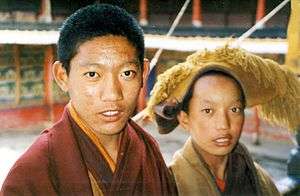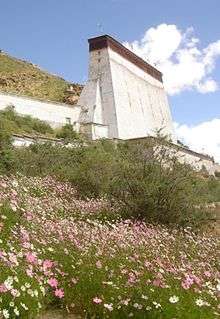Tashi Lhunpo Monastery
Tashi Lhunpo Monastery (Tibetan: བཀྲ་ཤིས་ལྷུན་པོ་ ), founded in 1447 by the 1st Dalai Lama,[1] is a historic and culturally important monastery in Shigatse, the second-largest city in Tibet.
| Tashi Lhunpo | |
|---|---|
Tibetan transcription(s) Tibetan: བཀྲ་ཤིས་ལྷུན་པོ་ Wylie transliteration: bkra shis lhun po Pronunciation in IPA: [ʈáɕi l̥ympo] Official transcription (China): Zhaxi Lhünbo THL: Trashi Lhünpo Other transcriptions: Tashi Lhunpo, Tashi Lhümpo Chinese transcription(s) Traditional: 扎什倫布寺 Simplified: 扎什伦布寺 Pinyin: Zhāshí Lúnbù Sì | |
 Entrance to Tashi Lhunpo Monastery | |
| Religion | |
| Affiliation | Tibetan Buddhism |
| Sect | Gelug |
| Location | |
| Location | Shigatse, Tibet Autonomous Region, China |
| Country | China |
 Location within Tibet Autonomous Region | |
| Geographic coordinates | 29.26861°N 88.869940°E |
| Architecture | |
| Founder | 1st Dalai Lama |
The monastery was sacked when the Gorkha Kingdom invaded Tibet and captured Shigatse in 1791 before a combined Tibetan and Chinese army drove them back as far as the outskirts of Kathmandu,[2] when they were forced to agree to keep the peace in the future, pay tribute every five years, and return what they had looted from Tashi Lhunpo.[3]
The monastery is the traditional seat of successive Panchen Lamas, the second highest ranking tulku lineage in the Gelug tradition of Tibetan Buddhism. The "Tashi" or Panchen Lama had temporal power over three small districts, though not over the town of Shigatse itself, which was administered by a dzongpön (prefect) appointed from Lhasa.[4]
Located on a hill in the center of the city, the full name in Tibetan of the monastery means "all fortune and happiness gathered here" or "heap of glory". Captain Samuel Turner, a British officer with the East India Company who visited the monastery in the late 18th century, described it in the following terms:
"If the magnificence of the place was to be increased by any external cause, none could more superbly have adorned its numerous gilded canopies and turrets than the sun rising in full splendour directly opposite. It presented a view wonderfully beautiful and brilliant; the effect was little short of magic, and it made an impression which no time will ever efface from my mind."[5]
Pilgrims circumambulate the monastery on the lingkhor (sacred path) outside the walls.
Although two-thirds of the buildings were destroyed during the excesses of the Chinese Cultural Revolution, they were mainly the residences for the 4,000 monks[6][7] and the monastery itself was not as extensively damaged as most other religious structures in Tibet, for it was the seat of the Panchen Lama who remained in Chinese-controlled territory.
However, during 1966 Red Guards led a crowd to break statues, burn scriptures and open the stupas containing the relics of the 5th to 9th Panchen Lamas, and throw them in the river. Some remains, though, were saved by locals, and in 1985, Choekyi Gyaltsen, 10th Panchen Lama, began the construction of a new stupa to house them and honour his predecessors. It was finally consecrated on 22 January 1989, just six days before he died aged fifty-one at Tashi Lhunpo. "It was as if he was saying now he could rest."[8]

History

The monastery was founded in 1447 CE by Gedun Drub, the disciple of the famous Buddhist philosopher Je Tsongkhapa and later named the First Dalai Lama. The construction was financed by donations from local nobles.
Later Lobsang Chökyi Gyalsten, the Fourth Panchen Lama and the first Panchen Lama to be recognized as such by the rulers of Mongolia, made major expansions to the monastery. Since then, all Panchen Lamas have resided at Tashi Lhunpo, and have managed to expand it gradually.
In 1791 the monastery was attacked and looted by an army of Nepalese Gurkha warriors but were driven out by the Chinese who simultaneously strengthened their control over the temple and Tibet.
Choekyi Gyalpo, the 11th Panchen Lama according to the government of the People's Republic of China, has been enthroned there, while Gedhun Choekyi Nyima, the 11th Panchen Lama recognised by the Dalai Lama, has been held under "protective custody" by Chinese authorities since 1995.
Tashi Lhunpo in its heyday housed over 4,000 monks and had four Tantric colleges, each with its own Abbot. After the death of a Panchen Lama, these four abbots led the search for his infant reincarnation and one of them always acted as a prime minister of Tsang under the control of the Dalai Lama in Lhasa.
In 1960, the monastery was dismantled by the Chinese army whilst the Panchen Lama was absent, although less damage was inflicted on the monastery than on most others around Tibet.
During the 1960s many senior lamas and monastics left Tibet and helped re-establish new monasteries in India, Nepal and Bhutan. The late Panchen Lama did not leave Tibet and consequently many of the senior lamas from Tashi Lhunpo Monastery remained inside Tibet. Therefore, while other monasteries-in-exile have expanded and developed under the guidance of senior lamas, Tashi Lhunpo has remained at a disadvantage, although in 1972 a new campus of Tashi Lhunpo Monastery was built by Tibetan exiles at a settlement in Bylakuppe, Karnātakā in southern India.
Since the early 1980s parts of the Tashi Lhunpo monastery have been open to the public and it is an important tourist attraction in Tibet today.
Branch monasteries
One of its branch monasteries was the famous Drongtse Monastery, 14 km north of Tsechen.[9]
See also
References
Citations
- Chö Yang: The Voice of Tibetan Religion and Culture. (1991) Year of Tibet Edition, p.79. Gangchen Kyishong, Dharmasala, H.P., India.
- Chapman, Spencer F. (1940). Lhasa: The Holy City, p. 128. Readers Union Ltd., London.
- Richardson (1984), p. 69.
- Chapman (1940), p. 141.
- Captain Samuel Turner, 'Embassy to the Court of the Teshu Lama,' p. 230. In: Das (1802). Reprint: (1988), p. 45, n.
- Dowman (1988), p. 273
- Chapman (1940), p. 140.
- Sun (2008), pp. 84-85.
- Dorje (1999), p. 261.
Sources
- Chapman, Spencer F. (1940). Lhasa: The Holy City. Readers Union Ltd., London.
- Das, Sarat Chandra. Lhasa and Central Tibet. (1802). Reprint: Mehra Offset Press, Delhi (1988).
- Dorje, Gyurme. (1999) Tibet handbook: with Bhutan, 2nd Edition. Footprint Travel Guides. ISBN 1-900949-33-4, ISBN 978-1-900949-33-0.
- Dowman, Keith. 1988. The Power-places of Central Tibet: The Pilgrim's Guide. Routledge & Kegan Paul, London and New York. ISBN 0-7102-1370-0
- Das, Sarat Chandra. Lhasa and Central Tibet. (1902). Edited by W. W. Rockhill. Reprint: Mehra Offset Press, Delhi (1988), pp. 40, 43 ff., 69, 114, 117, 149, 237; illustration opposite p. 50.
- Richardson, Hugh E. Tibet & its History. Second Edition, Revised and Updated. (1984). Shambhala Publications, Boston Mass. ISBN 0-87773-376-7.
- Sun, Shuyun (2008). A Year in Tibet. HarperCollins Publishers, London. ISBN 978-0-00-728879-3.
External links
| Wikimedia Commons has media related to Tashilhunpo. |
- Website of the Tashi Lhunpo Monastery in Bylakuppe
- Life on the Tibetan Plateau Tashi Lhunpo Monastery
- Le Tibet par la G219: bouddhisme, monastères et temples tibétains Photos made in 2012 (text in French).
- Grand Monastery of Tashi-Lhunpo 1902, Perry–Castañeda Library Map Collection, University of Texas, Austin
- Tashi Lhunpo Monastery UK Trust, a charity based in Salisbury, set up in 2003 to support the work of the monastery in exile